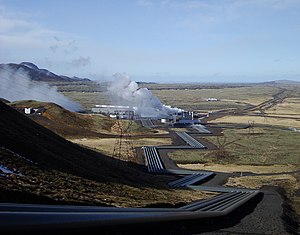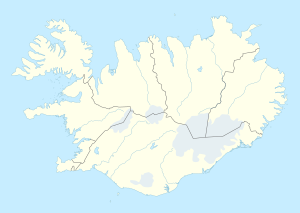Hellisheiði power station
| Hellisheiði power station | |||
|---|---|---|---|
| Hellisheiði power station | |||
| location | |||
|
|
|||
| Coordinates | 64 ° 2 '14 " N , 21 ° 24' 3" W | ||
| country | Iceland | ||
| Data | |||
| Type | Geothermal power plant | ||
| Primary energy | Geothermal energy | ||
| power | 303 megawatts electrical, 133 megawatts thermal |
||
| operator | Orkuveita Reykjavíkur | ||
| Start of operations | 2006 | ||
| Website | Hellisheiði Geothermal Plant | ||
The Hellisheiði power plant ( isl. Hellisheiðarvirkjun ) is a geothermal power plant on the Hellisheiði plateau in southwest Iceland . It is located in the area of the Hengill volcanic system between Reykjavík and Hveragerði .
Hot water and steam are extracted from 50 boreholes, which can be up to 2200 meters deep. The power plant uses it to generate electricity and warm water, which is pumped to Reykjavík.
development
Since 2006, two 45 MW turbines have been generating electrical energy. In the following year, a low-pressure turbine increased the output by 33 MW. In 2008 the area at Skarðsmýrarfjall was developed and two more turbines with 45 MW were connected. Hot water has been supplied since 2010. With two additional 45 MW turbines, over 300 MW of electrical energy has been generated since 2011.
With the hot water, an additional 400 MW of geothermal energy will be used.
The power plant has an information center for geothermal energy .
CO 2 storage
In 2006 the CarbFix project was started on the site of the Hellisheiði power plant. Originally initiated by the founding partners Reykjavik Energy, University of Iceland , Center national de la recherche scientifique and Earth Institute of Columbia University, the project now also includes other partners such as Amphos 21, Climeworks and the University of Copenhagen. As part of the CarbFix project, CO 2 and other acidic gases from emission sources or directly from the ambient air are captured ( DAC ) and permanently stored as rock in the subsurface ( DACCS ). The acid gases are pumped into the subsoil, where they react with the basalt present there and turn into carbonates themselves through natural processes. CarbFix is supported by the European Union as part of the FP7 and Horizon 2020 research programs.
In October 2017, a pilot system developed by the Swiss company Climeworks for storing CO 2 from the ambient air was put into operation on the site of the power plant . Climeworks filters the CO 2 directly from the ambient air , which is then mineralized and thus permanently removed from the atmosphere.
See also
Individual evidence
- ^ The Geothermal Energy Exhibition . Retrieved November 25, 2016.
- ↑ CarbFix: [1] Retrieved June 21, 2019.
- ↑ Bernd Schröder: Carbon dioxide from the air should be stored in rock. Telepolis , November 6, 2017, accessed November 12, 2017.

